Etsy Bundle
How Does Etsy Revolutionize Online Retail?
Etsy isn't just another online marketplace; it's a vibrant ecosystem where creativity thrives, connecting millions of buyers with unique, handcrafted treasures. In 2024, Etsy's financial performance, with a record-breaking $2.8 billion in revenue, highlights its dominance in the e-commerce world. This platform empowers independent sellers, offering them a global stage to showcase their distinctive products and build thriving businesses.
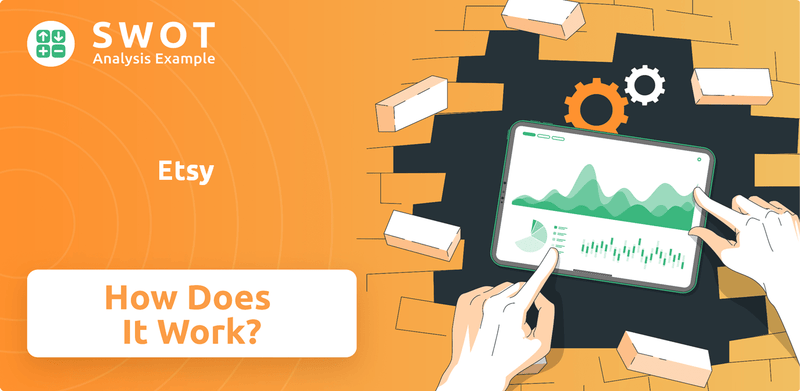
Etsy's success stems from its ability to foster a community of both buyers and sellers, creating a space where individuality is celebrated. For those looking to Etsy SWOT Analysis, understanding the inner workings of the Etsy business is crucial. This analysis will explore the Etsy platform's core operations, revenue models, and competitive advantages, providing valuable insights for anyone interested in the world of e-commerce and how to sell on Etsy.
What Are the Key Operations Driving Etsy’s Success?
The core operations of the online marketplace, Etsy, center around connecting independent sellers with buyers globally. This is achieved through its two-sided Etsy platform, fulfilling its mission to 'Keep Commerce Human'. The company's value proposition lies in offering unique, handmade, vintage, and craft supply items, differentiating it from traditional retail channels.
This niche focus attracts a specific customer segment seeking personalized and one-of-a-kind products. The operational processes include technology development for its online marketplace and mobile applications, ensuring a user-friendly interface for both buyers and sellers. Furthermore, Etsy provides sellers with tools to manage their shops, process payments, and access customer support.
Etsy's decentralized supply chain relies on individual sellers to source materials, create products, and manage their own shipping. The company supports this through services like shipping labels and integrated payment processing. The 'House of Brands' portfolio further extends its reach, including Reverb and Depop. Each brand operates independently while benefiting from shared expertise in product development, marketing, technology, and customer support.
Etsy provides a user-friendly interface for both buyers and sellers. Sellers can easily list items, manage orders, and process payments. Buyers can browse a vast selection of unique products and make purchases with ease.
The Etsy platform offers marketing tools, such as Etsy Ads, to help sellers enhance visibility and drive sales. These tools allow sellers to reach a wider audience and increase their chances of making a sale. This is a crucial aspect of any Etsy business.
Etsy fosters a community that attracts and retains talented makers. This community-driven approach and the emphasis on unique, handcrafted items differentiate Etsy from larger e-commerce platforms like Amazon and eBay. This focus creates a loyal customer base.
The supply chain is decentralized, relying on individual sellers to source materials, create products, and manage their own shipping and logistics. Etsy supports this through services like shipping labels and integrated payment processing, streamlining the process for sellers.
As of December 31, 2024, the Etsy marketplace had over 100 million items listed, with approximately 30% of its 2024 GMS coming from custom or made-to-order merchandise. This highlights the unique nature of its inventory and its appeal to customers seeking personalized products. The company's commitment to fostering a community and its focus on human connection in commerce are key differentiators. To learn more about how Etsy markets itself, you can read about the Marketing Strategy of Etsy.
Etsy distinguishes itself through several key factors, including its focus on unique, handmade, and vintage items, its community-driven approach, and its decentralized supply chain model.
- Unique Product Selection: Offers items not readily available in traditional retail.
- Community Focus: Fosters a community that attracts and retains talented makers.
- Decentralized Supply Chain: Relies on individual sellers, supported by Etsy's services.
- Marketing Tools: Provides tools like Etsy Ads to help sellers increase visibility.
Etsy SWOT Analysis
- Complete SWOT Breakdown
- Fully Customizable
- Editable in Excel & Word
- Professional Formatting
- Investor-Ready Format
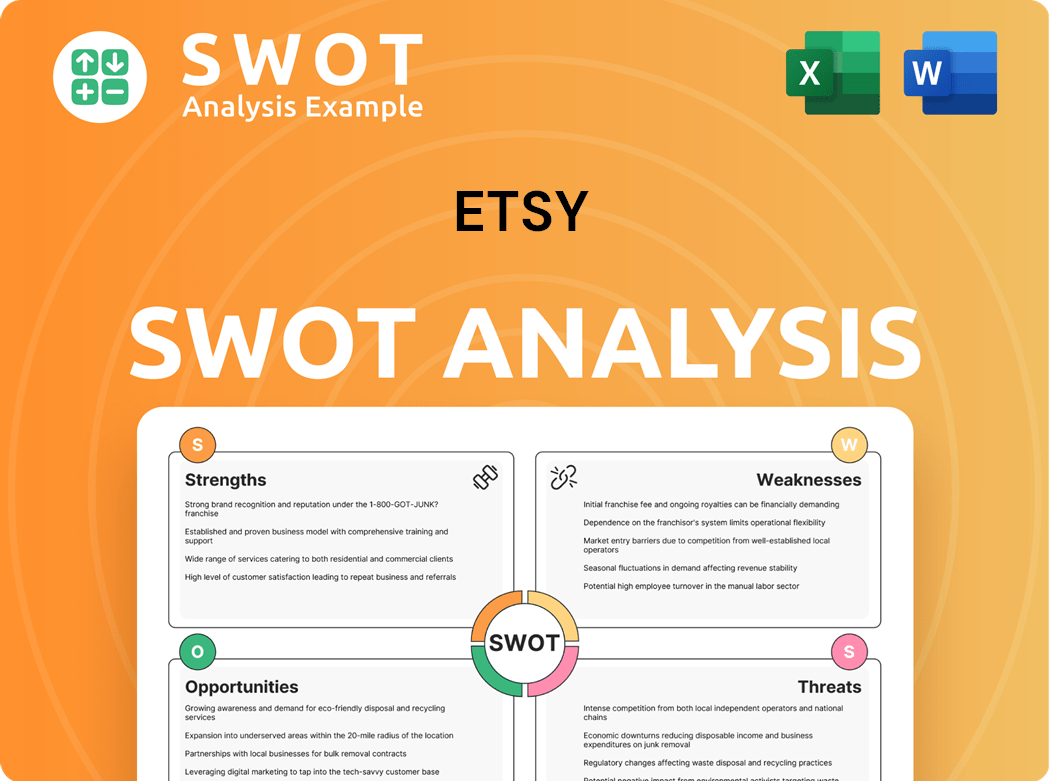
How Does Etsy Make Money?
Etsy's revenue model is built on a foundation of marketplace fees and services designed to support its sellers. The company's ability to generate revenue is directly tied to the activity of its sellers and the overall health of the e-commerce market. Understanding these revenue streams is key to grasping how the Etsy business operates.
In 2024, Etsy generated a total revenue of $2.808 billion, marking a 2.18% increase year-over-year. This revenue is divided into two main categories: Marketplace Revenue and Services Revenue. These streams reflect how Etsy monetizes its online marketplace and the additional services it offers to its sellers.
The Etsy platform provides various opportunities for sellers to generate income, and the company itself uses several strategies to generate revenue. The following sections break down the specifics of how Etsy makes money, providing insights into its financial structure and how it supports its community of sellers.
Marketplace Revenue is the primary source of income for Etsy, accounting for 72% of the total revenue in 2024. This revenue stream is directly tied to the activity of sellers on the platform and includes fees for listing items and transaction commissions.
Sellers are charged a small fee of $0.20 for each item they list on the platform. This fee applies regardless of whether the item sells and renews every four months or upon a sale. This is a consistent, recurring revenue stream for Etsy.
Etsy takes a 6.5% commission on the total sale price of an item, including shipping and gift wrapping costs. This is a significant revenue driver, as it is directly proportional to the volume of sales on the platform.
Services Revenue makes up 28% of Etsy's total revenue. This category includes a variety of services designed to help sellers increase sales and manage their shops more effectively. These services provide additional revenue streams for the company.
Etsy charges a fee for transactions processed through Etsy Payments. In the US, this is typically 3% of the transaction price plus $0.25, with variations in other countries. In 2024, 98% of Gross Merchandise Sales (GMS) were processed through Etsy Payments.
Sellers can pay for Etsy Ads to increase the visibility of their listings. Additionally, Offsite Ads allow Etsy to advertise listings on external platforms, charging sellers a 12-15% fee only when a sale results from these ads. Advertising was a key driver for Services revenue growth in Q4 2024.
Beyond the core revenue streams, Etsy also generates income through subscription plans and shipping labels. These services enhance the overall value proposition for sellers on the platform.
- Subscription Plans: Etsy offers plans like Etsy Plus, which provide sellers with extra tools and benefits for a monthly fee.
- Shipping Labels: Etsy facilitates the purchase of shipping labels, generating revenue from this service.
- In Q1 2025, consolidated revenue was $651.2 million, up 0.8% year-over-year, with services revenue increasing by 7.7% to $192.7 million, largely due to strong demand for on-site advertising and a new seller setup fee.
- Etsy's 'take rate' (consolidated revenue divided by consolidated GMS) reached 22.8% in Q4 2024 and a new high of 23.3% in Q1 2025, reflecting enhanced monetization of platform activity.
Etsy PESTLE Analysis
- Covers All 6 PESTLE Categories
- No Research Needed – Save Hours of Work
- Built by Experts, Trusted by Consultants
- Instant Download, Ready to Use
- 100% Editable, Fully Customizable
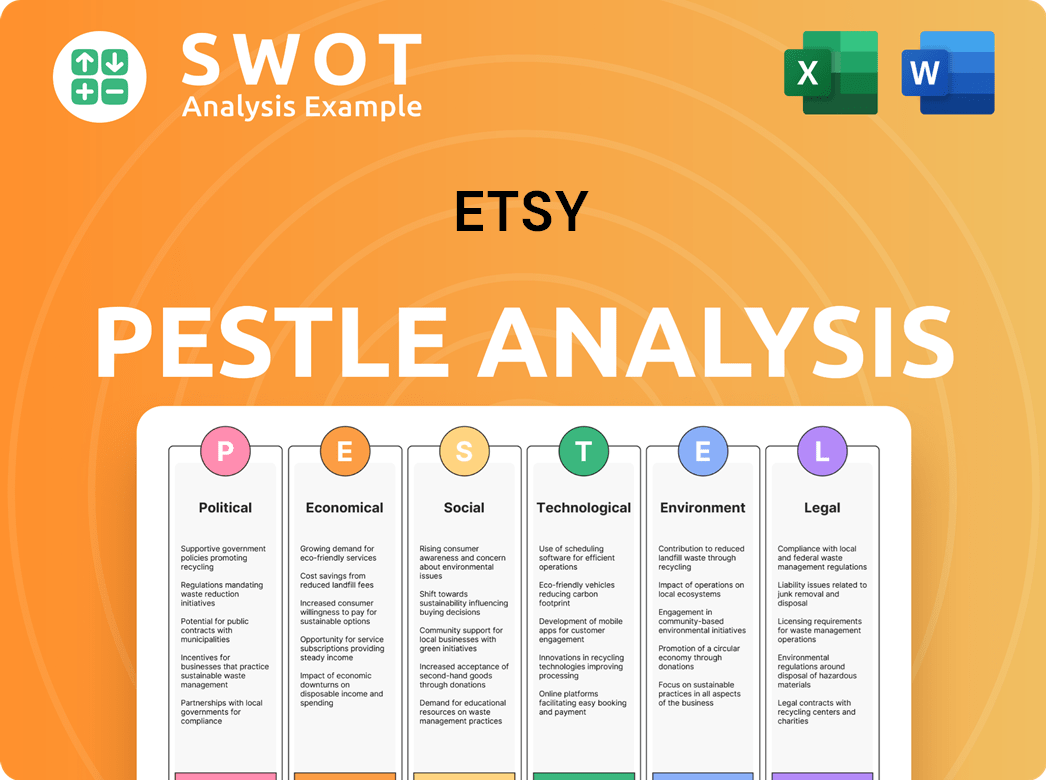
Which Strategic Decisions Have Shaped Etsy’s Business Model?
The journey of the online marketplace, Etsy, since its 2005 founding, has been marked by strategic initiatives aimed at solidifying its position in the e-commerce landscape. The platform has grown significantly, building a vibrant two-sided marketplace that connects buyers and sellers of unique, handmade, and vintage items. Strategic moves, including acquisitions and divestitures, have been crucial in shaping its portfolio and competitive stance.
A key strategic move has been the expansion of its 'House of Brands' portfolio. This includes the 2019 acquisition of Reverb (musical instruments) and the 2021 acquisition of Depop (fashion resale). These acquisitions have contributed to the diversification of the platform's offerings. Conversely, the sale of Elo7, a Brazil-based marketplace, in August 2023, streamlined the company’s focus.
Operational challenges have included pressure on consumer spending and a highly promotional retail environment. Despite these headwinds, the platform has demonstrated resilience, achieving record-high quarterly revenue in Q4 2024. This resilience is partly attributed to increased monetization of platform activity, reflected in a higher take rate. The company continues to invest in technology and adapt to changing market dynamics.
Founded in 2005, the platform quickly established itself as a go-to destination for unique, handmade, and vintage goods. Strategic acquisitions, such as Reverb and Depop, expanded its market reach. The sale of Elo7 in 2023 streamlined operations, focusing on core strengths.
Expansion through acquisitions like Depop and Reverb diversified the offerings. Focus on technology investments, including AI and machine learning, to enhance user experience. Ongoing policy updates to improve security and streamline processes for both buyers and sellers.
Strong brand identity associated with unique and handmade items. A loyal community of buyers and sellers contributes to its marketplace strength. User-friendly interface and robust support system for sellers differentiate the platform.
Despite market challenges, the platform achieved record-high quarterly revenue in Q4 2024, reaching $852.2 million. Consolidated GMS for 2024 was $12.6 billion, a 4.5% decrease from 2023. Increased monetization efforts have helped maintain revenue growth.
The platform's competitive advantages stem from its strong brand identity, synonymous with unique items, and a loyal community. Its 'Right to Win' strategy focuses on unique items, top-notch search and discovery, human connections, and a trusted brand. The platform continues to invest in technology to enhance both buyer and seller experiences.
- The platform's brand is associated with unique, handmade, and vintage items.
- A loyal community of buyers and sellers supports the marketplace.
- The platform invests in technology, including AI, to improve search and discovery.
- The company’s focus is on quality, reliability, and buyer consideration.
The platform's strategy includes continuous investment in technology, such as machine learning and conversational AI, to improve search and discovery, and enhance the user experience. For those looking to start an Etsy business, understanding the platform's dynamics is crucial. For more insight into the target market, consider exploring the Target Market of Etsy.
Etsy Business Model Canvas
- Complete 9-Block Business Model Canvas
- Effortlessly Communicate Your Business Strategy
- Investor-Ready BMC Format
- 100% Editable and Customizable
- Clear and Structured Layout
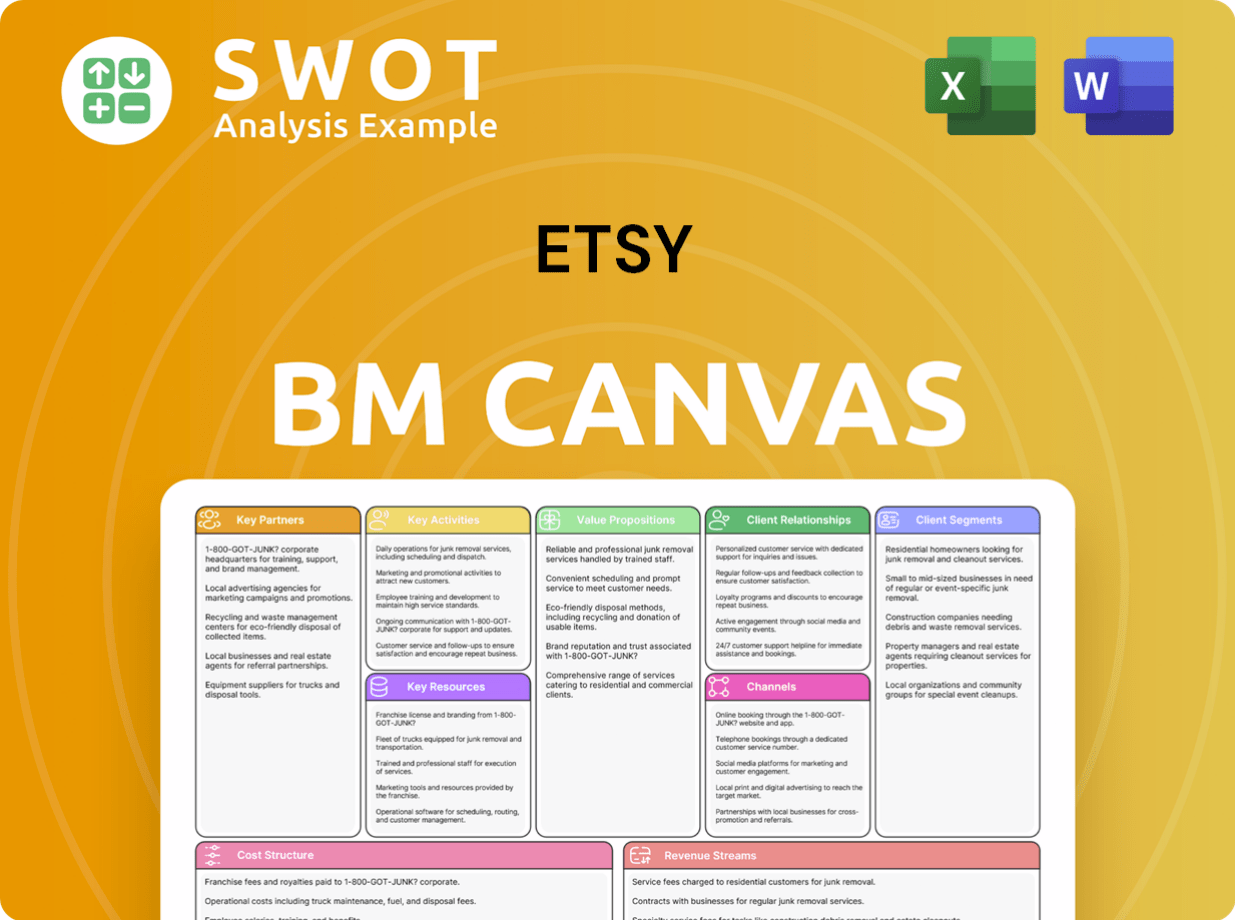
How Is Etsy Positioning Itself for Continued Success?
Etsy holds a strong market position within the e-commerce sector, differentiated by its focus on handmade, vintage, and craft supply items. This niche distinguishes it from competitors like Amazon Handmade, eBay, and Shopify. The Etsy platform connects millions of sellers and buyers, fostering a community-driven online marketplace. As of December 31, 2024, the platform had 8.1 million active sellers and 95.5 million active buyers.
However, despite its unique position, the Etsy business faces various challenges. These include market saturation, higher seller fees, and macroeconomic pressures impacting consumer spending. Although revenue continues to grow, the company experienced a 4.5% year-over-year decrease in Gross Merchandise Sales (GMS) in 2024, reaching $12.5 billion. In Q1 2025, GMS decreased by 6.5% to $2.8 billion, while revenue reached $651.2 million, reflecting an increase in take rate.
Etsy's focus on handmade and vintage goods creates a unique niche within the e-commerce landscape. The platform's community-driven approach and specialized offerings set it apart. The company competes with broader e-commerce sites but maintains a distinct identity.
Market saturation presents a challenge for new sellers to stand out. Higher fees and macroeconomic factors, such as reduced consumer spending, can impact profitability. Dependence on a niche market limits overall scope compared to general e-commerce sites.
Etsy aims to drive buyer consideration and frequency, focusing on enhancing the buyer experience. Investments in AI and machine learning for search and discovery are key. The company plans to leverage its unique product offerings and community for long-term growth.
The company is focused on improving the buyer experience through personalization. Strengthening trust in the brand via a safe purchasing experience is a priority. The sale of Reverb indicates a strategic focus on core marketplaces.
Etsy is focused on sustaining growth through several strategic initiatives, including enhancing the buyer experience and improving search and discovery. The company aims to leverage its unique product offerings and strong community to drive long-term growth and market share gains. The company is also focused on ensuring a safe and reliable purchasing experience to build trust.
- Enhancing the buyer experience through personalization.
- Improving search and discovery using AI and machine learning.
- Strengthening trust in the brand by ensuring a safe purchasing experience.
- Focusing on high-quality listings and reliable delivery.
Etsy's strategic initiatives include leveraging its unique product offerings, strong community, and disciplined investment strategy. The company's leadership expresses confidence in its ability to sustain growth, aiming to return to GMS growth. To understand more about the financial aspects of the company, you can explore the details provided in Owners & Shareholders of Etsy.
Etsy Porter's Five Forces Analysis
- Covers All 5 Competitive Forces in Detail
- Structured for Consultants, Students, and Founders
- 100% Editable in Microsoft Word & Excel
- Instant Digital Download – Use Immediately
- Compatible with Mac & PC – Fully Unlocked
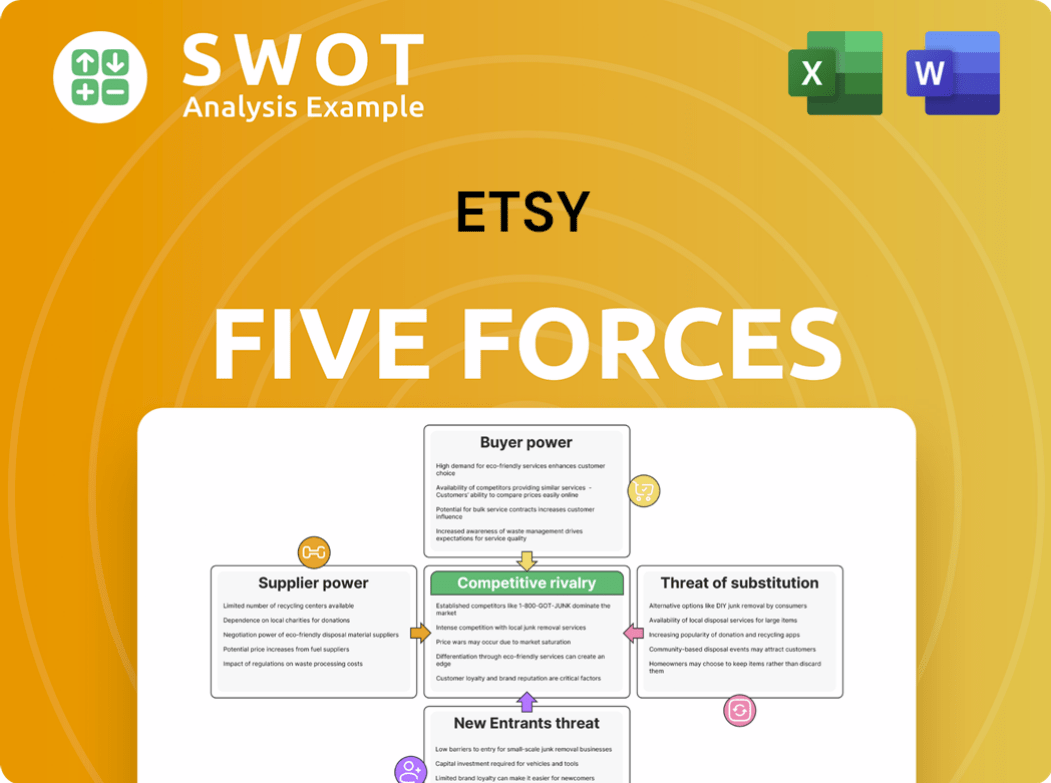
Related Blogs
- What are Mission Vision & Core Values of Etsy Company?
- What is Competitive Landscape of Etsy Company?
- What is Growth Strategy and Future Prospects of Etsy Company?
- What is Sales and Marketing Strategy of Etsy Company?
- What is Brief History of Etsy Company?
- Who Owns Etsy Company?
- What is Customer Demographics and Target Market of Etsy Company?
Disclaimer
All information, articles, and product details provided on this website are for general informational and educational purposes only. We do not claim any ownership over, nor do we intend to infringe upon, any trademarks, copyrights, logos, brand names, or other intellectual property mentioned or depicted on this site. Such intellectual property remains the property of its respective owners, and any references here are made solely for identification or informational purposes, without implying any affiliation, endorsement, or partnership.
We make no representations or warranties, express or implied, regarding the accuracy, completeness, or suitability of any content or products presented. Nothing on this website should be construed as legal, tax, investment, financial, medical, or other professional advice. In addition, no part of this site—including articles or product references—constitutes a solicitation, recommendation, endorsement, advertisement, or offer to buy or sell any securities, franchises, or other financial instruments, particularly in jurisdictions where such activity would be unlawful.
All content is of a general nature and may not address the specific circumstances of any individual or entity. It is not a substitute for professional advice or services. Any actions you take based on the information provided here are strictly at your own risk. You accept full responsibility for any decisions or outcomes arising from your use of this website and agree to release us from any liability in connection with your use of, or reliance upon, the content or products found herein.